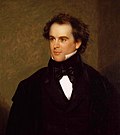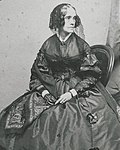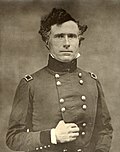Franklin Pierce
Franklin Pierce (November 23, 1804 – October 8, 1869) was the 14th president of the United States (1853–1857) and is the only president from New Hampshire. He was a Democrat and a "doughface" (a Northerner with Southern sympathies) who served in the U.S. House of Representatives and the U.S. Senate. His presidency is mostly remembered for the disastrous Kansas-Nebraska Act, which set the country towards th American Civil War. His presidency is regarded as one of the worst in American history.
Franklin Pierce | |
|---|---|
 Portrait by George Peter Alexander Healy, 1853 | |
| 14th President of the United States | |
| In office March 4, 1853 – March 4, 1857 | |
| Vice President | William R. King |
| Preceded by | Millard Fillmore |
| Succeeded by | James Buchanan |
| United States Senator from New Hampshire | |
| In office March 4, 1837 – February 28, 1842 | |
| Preceded by | John Page |
| Succeeded by | Leonard Wilcox |
| Member of the U.S. House of Representatives from New Hampshire's At-large district | |
| In office March 4, 1833 – March 4, 1837 | |
| Preceded by | Joseph Hammons |
| Succeeded by | Jared Williams |
| Personal details | |
| Born | November 23, 1804 Hillsborough, New Hampshire |
| Died | October 8, 1869 (aged 64) Concord, New Hampshire |
| Nationality | American |
| Political party | Democratic |
| Spouse(s) | Jane Appleton Pierce |
| Religion | Anglican Church |
Early life
Pierce was born on November 23, 1804, in Hillsborough, New Hampshire.[1] He attended school at Hillsborough Center but then moved to Hancock Academy in Hancock, New Hampshire, at the age of 12. After attending school there for five years, he was transferred to Phillips Exeter Academy in the spring of 1820. After he entered, he felt homesick and returned home.
That mad his father put him in a wagon, drive him halfway back to school, and leave him on the roadside without saying a word. Franklin walked the seven remaining miles back to school. Later that year, he was transferred to Phillips Exeter Academy to prepare for college.[1] That fall, he was sent to Bowdoin College in Brunswick, Maine. While he was there, he participated in literary, political, and debating clubs. During his second year there, his grades were the lowest in his class, but he improved them and graduated with the rank of fifth in his class.
Career
Once finished with college, he went to law school in Northampton, Massachusetts.[1] Pierce was admitted to the bar and began law practice in Concord, New Hampshire, in 1827. Pierce rose to a central position in the Democratic Party of New Hampshire and was elected to the lower house in New Hampshire’s General Court in 1828.
Pierce served in the State House from 1829 to 1833 and also served as Speaker from 1832 to 1833. In 1832, Franklin was elected as a Democrat to the 23rd and 24th of Congress from March 4, 1833 to March 4, 1837.[1] At 27 years of age, Pierce was the youngest U.S. Representative at that time. In 1836, he was elected by the New Hampshire General Court as a Democrat to the U.S Senate, serving from March 4, 1837, to February 28, 1842.
After serving in the Senate, Pierce went back to Concord to resume law practice. He then was U.S. Attorney from 1845 to 1847 for the district of New Hampshire though he declined th Democratic nomination for governor of New Hampshire and refused the appointment as General of the United States.
Personal life
On November 19, 1834, Pierce married Jane Means Appleton.[1] They had three children, all of whom died in childhood. Franklin Pierce Jr. died only three days after birth; and Frank Robert Pierce died at four years of age from epidemic typhus. Just two months before his inauguration, Franklin Pierce and his family boarded a train that was bound for Boston, Massachusetts. Shortly afterward, their derailed car started to roll down an embankment.[1] Franklin and Jane survived and were merely shaken up, but they saw their 11-year-old son Benjamin get crushed to death. Jane Pierce thought the train accident was a divine punishment for Franklin’s pursuit and acceptance of high office.
President years
Pierce served as U.S. president from March 4, 1853, to March 4, 1857. He was the first president to “affirm” his oath of office instead of swearing it (the only other president to do so has been Herbert Hoover).[2] Rather than placing his hands on the Bible, Pierce placed his hands on a law book, the first to do so.[3] He was also the first president to recite his inaugural address from memory. Surprisingly, Pierce selected men of different opinions for his Cabinet. Many people expected a diverse group to break up quickly, but the Cabinet stayed together for all of Pierce’s four-year term.
Pierce’s toughest challenge as president was the passage of the Kansas-Nebraska Act in 1854. The act repealed the Missouri Compromise and, in the West, reopened the question of slavery. That and other things triggered a series of violent events called Bleeding Kansas. Pro-slavery Border Ruffians, mostly from Missouri, illegally voted for a government that Pierce recognized. He called the anti-slavery Topeka Constitution, which was set up by Free-Staters, as an act of “rebellion.”
Overall, Pierce is ranked among the least effective presidents since he was unable to steer a steady or prudent course.
Later life
After losing the Democratic nomination for the 1856 presidential election, Pierce retired with his wife. He died in Concord, New Hampshire, of cirrhosis on October 8, 1869 at the age of 64.[1] He was buried in Old North Cemetery in Concord.
Franklin Pierce Media
Novelist Nathaniel Hawthorne, a lifelong friend of Pierce, wrote the biography Life of Franklin Pierce in support of Pierce's 1852 presidential campaign.
Pious and reserved, Jane Pierce was her husband's opposite in many ways.
The Concord, New Hampshire house where Pierce lived from 1842 to 1848; now known as the Pierce Manse, it was restored in the 1970s and is maintained as a historic attraction.
Pierce's brief term as a general in the Mexican–American War boosted his public image.
References
- ↑ 1.0 1.1 1.2 1.3 1.4 1.5 1.6 "Franklin Pierce". The White House. Archived from the original on June 20, 2022. Retrieved December 16, 2024.
- ↑ Hess, Stephen (2008). What do we do now?: a workbook for the president-elect. Brookings Institution Press. p. 129. ISBN 978-0-8157-3655-4.
- ↑ "Learn more about the only US president from New Hampshire, Franklin Pierce". WMUR. Retrieved December 16, 2024.
Other websites
- Pierce's White House biography Archived 2009-01-17 at the Wayback Machine







